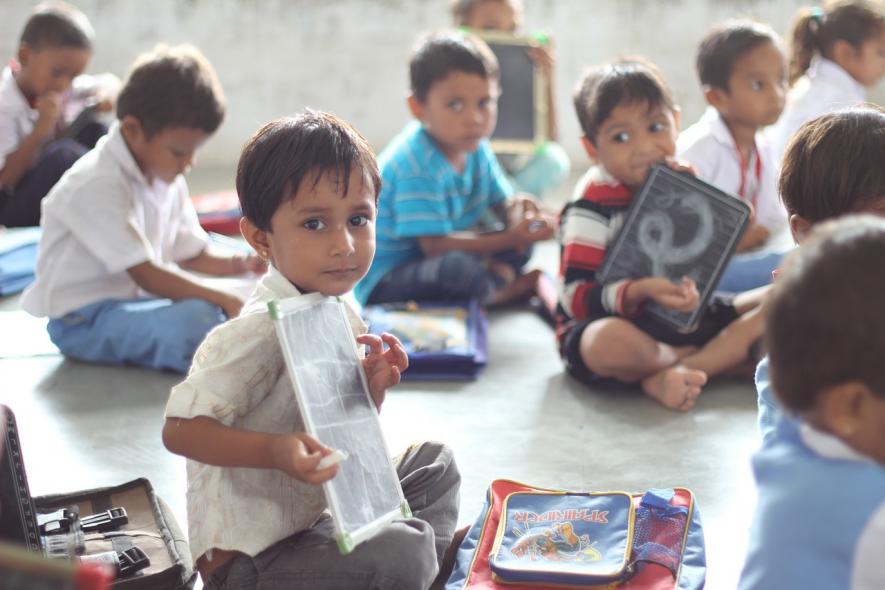New Exploitation Policy

Certain circles have predictably welcomed the New Education Policy as a revolutionary reform of our education system. There is little doubt that our education system has been in need of radical and extensive reconstruction as it has failed dismally to meet the expectations of the people. But the New Education Policy (NEP) adopted by the central Cabinet without any discussions in Parliament not only belies those expectations but proposes to deny people their right to a sound education fairly comprehensively. The ABVP says it will enable every student to dream but in practice it is certain to wreck such dreams and break hearts.
Indeed right from the word go this government seems to be launching one murderous attack after another on the people at regular intervals, the latest being the new Environmental Impact Assessment rules on the anvil and this New Education Policy.
Though it has been drummed up as a game-changer it is in fact a continuation and acceleration of the policy of privatisation and commercialisation of education that began with former prime minister Rajiv Gandhi’s initiative, heralded by mass circulation of a booklet called “Perspectives on Education”. The booklet had reportedly been prepared in consultation with British experts during the heyday of neo-liberal upsurge in the West, and it first broached the idea of a Public-Private Partnership in management of education.
At that time however, neo-liberal ideas were being introduced gently, and popular feedback was taken into account as there was a need to breach the solid walls of public control. The early nineties, when during Dr Manmohan Singh’s watch India embraced the doctrine of neo-liberal reforms openly, the masters of international capital favoured a democratic approach and allowed all manner of criticism and protest. But as the neo-liberal (imperialist, to be frank) system found a grip and tightened it into a stranglehold, all need for such restraint was abandoned and a naked face of economic and political oppression unmasked itself. The much-vaunted “safety net” was tattered and it developed gaping holes that made a mockery of safety for people’s lives and livelihoods.
All indications suggest the New Education Policy approved by the Union
Cabinet took little notice of feedback from various quarters critical of the policy. No wonder Parliament had been sidelined while approving the policy. As in other policies adopted by the new NDA government public discussions are given short shrift in a matter where the public is a major stakeholder. The interest of the corporates is predominant, though offered with garnishing of traditional Hindu culture.
There are two doubts that at once spring to mind. A few years ago when certain well-known foreign academic institutions showed interest in opening campuses in India they were asked if degrees from such campuses would carry the same weight as those given by the mother institutions, they hastily drew back. Hence even if some other institutions come to India today following the new policy, the result may be well be lowering of academic standards while increasing costs.
Then a more fundamental question. The new policy abolishes education as a public good to which all citizens have a claim as by right. In place of that it seeks to introduce education as a commodity for choice and sale. Branded differently and packaged with business expertise it might well turn out to be a very different product than what is hawked about in the market-place. The Covid-19 crisis has already exposed the terrible consequences of dismantling of another vital public good, health care.
This new policy is to be implemented within ten years. What will be the fate of millions of students caught in the middle? There is no plan for the transition period, no cushioning of the shock, nor adequate steps to repair the damage inflicted. During the interregnum, buffeted this way and that and kept in the shadows, their fortunes might suffer miserably. This is significant as indicative of the callousness of the general approach.
Actually all such reforms in recent times had in their outward package alluring visions of equitable development and justice for all. In practice these have meant a cruel joke on students from poorer and backward classes resulting in mass privation and frustration enabling “employers” to waive them away as “unemployables”. The Kothari Commission of 1964 had submitted the only report that first, recommended adequate resources for putting life into a moribund system and restructuring the system into a potentially healthy one meeting the needs and aspirations of an independent living democratic state. Unfortunately its honest and achievable objectives were diluted, foiled by unscrupulous politicians who skimped resources and arrogant bureaucrats in their thirst for control over-ruling popular participation. Now the system has been “reformed” to ensure a business-bureaucracy participation.
We are told there will be an outlay of 6% of the GDP on education, though one has doubts the government will be so generous. The excuse of current GDP decline may well be cited to pare it down further. Now when we are disarmingly told that public and private institutions will receive equal support from government, it will mean siphoning of precious public resources for profiteering private agencies. Given the partiality of current governments to private business it may end in delivering the better part of the outlay to resource-rich private institutions, leaving the poorer public institutions gasping for breath.
The final outcome will be concentration of required funds in elite private institutions, the products of which will move into multi-national business, financial and industrial houses that have little concern for people at large. So our public funds will be deployed to produce skilled managerial, research-oriented and technical corps for international monopolists with not a whit of interest in promotion of the welfare of their countrymen. The “nation” will be effectively turned into a labour-depot for sophisticated exploitative business.
The curriculae will be similarly upgraded for catering to standards of elite private institutions at the school level, forgetting students from less-advantaged and poorer backgrounds and public institutions. Ultimately, the struggling public institutions will be compelled to hand over their control to private educational management. The fee structure will be revised to bar poorer students, and also freeze the age-old iniquities of caste. The disgraceful sop of making all colleges autonomous eventually will result in unaffordable hikes in fees and a terrible decline in standards, as without assistance from a public body like the University Grants Commission (UGC), the colleges with poorer resources will be forced to compromise on quality and the regulatory supervision of universities. A few exceptions here and there will make no difference to the general rule.
Here my experience of mofussil colleges should prove instructive. Long back, following an updating of Major/Honours syllabi and introduction of the semester system, I was member of a university team on inspection tours of a few mofussil colleges. Each semester was devoted to teaching four big chunks of the syllabus covering disparate and wide fields of study. But these colleges had only two or at most three teachers who also had to cover Higher Secondary and BA/BSc pass classes. These teachers were required to bear a back-breaking burden, score periodic tests and hold seminars as well. The college library had few books as UGC funds went into building libraries. The students cribbed from google without understanding most of it. And a new semester started without results of the previous semester coming out well into the middle of it. One imagines academics sitting in Delhi and issuing model syllabuses had no idea of the mess they were making of Honours/Major teaching in small towns.
The brouhaha about regional languages getting a breather from the octopus of single-language monopoly also makes little sense. The child will learn through mother tongue the first lessons up to his 10th or 11th year of age, and his guardians will then decide the medium. Since the central entrance examination for college is bound to be in English or Hindi the child’s guardian is likely to opt for either for higher classes at school. That will effectively erase from memory his native regional language which as a result will wilt for want of support. Even if he retains them it will be only the very basics giving no hint of the richness of the language and its literature. Ultimately it will mean prevalence of two to four major languages and push others to the wall.
Providing drop-outs at the degree level with certificates and diplomas also is probably designed to deceive. For what will be the level of knowledge if after two semesters a student gets a certificate or a diploma after one semester? How will it equip him to find employment or use this knowledge in any gainful way? Because of the inevitable fee hikes there is bound to be many dropouts, and we shall have an army of half-educated young men and women as dregs of this gigantic processing mill.
The implementation of the ideal objectives like abolition of different streams like Arts, Science and Commerce to allow freedom of choice to students may also be more noise than substance as colleges in poorer regions may offer very limited choice. It is unlikely that in years to come they will have enough resources.
All in all these so-called reforms will deepen class-divisions and widen already existing disparities. This is a bad omen indeed for our democracy as it will turn democratic ideas of equality, freedom to develop one’s capabilities according to talent and scope for social mobility. Indeed it may be one more nail on the coffin of democracy.
The author is a socio-political commentator and cultural critic. The views are personal.
Get the latest reports & analysis with people's perspective on Protests, movements & deep analytical videos, discussions of the current affairs in your Telegram app. Subscribe to NewsClick's Telegram channel & get Real-Time updates on stories, as they get published on our website.
























